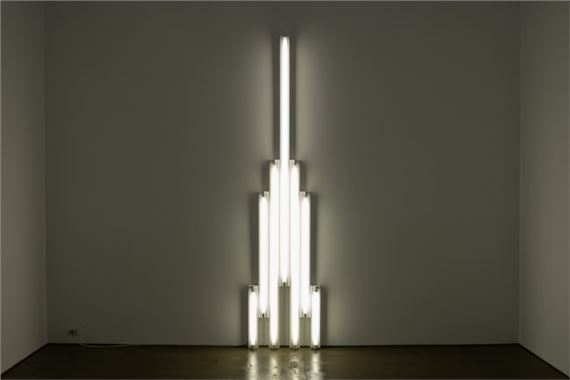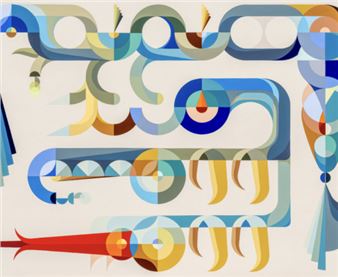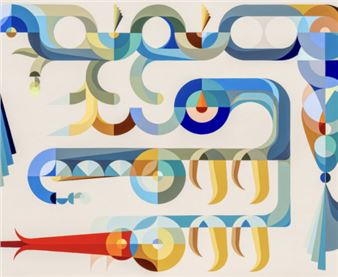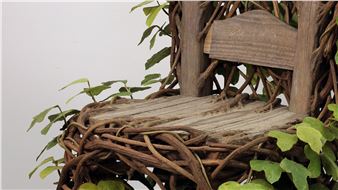The Ray Gun Store
In December 1961, Claes Oldenburg opened and operated The Store at 107 East 2nd Street in Manhattan. Filled with a series of assemblages in the shape of pastries, hamburgers, articles of clothing, Oldenburg offered a new way to consume the creature comforts of post-war American life. On the exhibitionŌĆÖs poster, his simulacra were partially credited to the ŌĆ£Ray-Gun MFG [Manufacturing] Co.ŌĆØ A fictional weapon that has been a motif in science fiction since the late 19th century, ray guns (or ray-guns, rayguns) recur in OldenburgŌĆÖs practice, most notably in the Ray Gun Wing from 1977ŌĆöa structure in the shape of the gun that displayed over 300 toys and sculptures of the deadly weapon.
The Ray Gun Store revisits the transformative movements that emerged in New York in the seminal decade 1961-71 through the private collection of Marc and Livia Straus. This not-for-sale exhibition features major works by some of the greatest artists of the 20th century, including Oldenburg, Dan Flavin, Ellsworth Kelly, Frank Stella, Larry Rivers, Jasper Johns, Roy Lichtenstein, Kenneth Noland, Carl Andre, Jules Olitski, and Charles Hinman. Part benchmark of the StrausesŌĆÖ early collecting years and part curated survey of the rise of Pop Art, Minimalism, and Color Field painting, the exhibition will be on view in Tribeca from August 11 through September 30, with an opening event on September 12 from 5ŌĆō8 PM.
Before opening his first gallery on the Lower East Side in 2011, Marc Straus practiced medical oncology for 35 years. He began collecting while still a medical studentŌĆöfocusing particularly on the then-emerging artists featured in this exhibition, many of whom he knew personally.
Of this time, Marc Straus says, ŌĆ£Something really radical was happening in the American vernacular of art, we began to have our own American language with the birth of Pop Art. I was completely taken by the artists who dared to go into a new direction, and started working weekend jobs during medical school to be able to afford works I was passionate about and to live with them.ŌĆØ
Despite limited funds, Marc Straus and his wife Livia began acquiring art guided by three rules: they had to love the work, choose what they believed was the artistŌĆÖs best piece, and be able to afford it.
The StrausesŌĆÖ first contemporary purchase was Kenneth NolandŌĆÖs Shift (1966)ŌĆöa large, diamond-shaped canvas measuring just two feet high by eight feet wide, composed of four bands of color. The painting, later included in NolandŌĆÖs 1977 retrospective at the Guggenheim Museum, is part of his iconic chevron series. Beginning in 1963, Noland used the chevron as a neutral structure to emphasize what he considered the true focus of his work: color. He often applied thinned acrylic paints directly onto unprimed canvas, allowing the pigment to soak into the surfaceŌĆöa technique he called ŌĆ£one-shot painting,ŌĆØ as it left little room for correction or revision.
Color and scale are also central elements in Ellsworth KellyŌĆÖs Chatham VIII (1970), an inverted L-shaped composition formed by two joined canvasesŌĆöone red, one yellow. The painting is part of KellyŌĆÖs 14-work Chatham series, named after the town in upstate New York where he maintained a studio at the time. The Strauses were the first to purchase work from the series. The piece was $9,000ŌĆöthe equivalent of MarcŌĆÖs annual salary as a resident physician. It took them six months to find a bank willing to finance the sale, which they repaid over three years. Not another Chatham painting sold for seven years. The work was later featured in MoMAŌĆÖs 2013 exhibition that reunited the entire series in celebration of KellyŌĆÖs 90th birthday.
In the late 1950s, Frank Stella rejected the Abstract Expressionist notion of art as a vehicle for emotional expression, instead emphasizing the material qualities of painting and focusing on the formal elements of line, shape, color, and composition. In his Protractor series (1967ŌĆō71)ŌĆöinspired by the arches and decorative patterns he encountered in Iranian art and architecture during travels in Western AsiaŌĆöStella painted bright, curved bands of color that echo the semi-circular form of the mathematical tool. Flin Flon (1970) is a key example from this pivotal body of work, which marked a creative turning point for the artist, as he shifted from the austere, monochromatic geometry of the Black Paintings to the vibrant exuberance that would define his later work.
Larry Rivers, by contrast, used expressive brushwork to depict the familiar objects and images that populate everyday life. In The Friendship of America and France (1961ŌĆō62), images of Kennedy and De Gaulle appear alongside American and French cigarette packages, presenting the two cultures side by side in what Marc considers ŌĆ£the first American Pop painting.ŌĆØ
While Rivers is often referred to as the ŌĆ£GodfatherŌĆØ or ŌĆ£GrandfatherŌĆØ of Pop Art, Carl Andre is widely regarded as one of the most influential pioneers of Minimalist sculpture. The title of his 64 Aluminum Squares (1969) is a succinct description of the work: eight rows of eight aluminum plates laid out in a precise grid on the floor. This piece is a notable example of the artistŌĆÖs sculptural ŌĆ£literalismŌĆØŌĆöhis use of industrial materials arranged in modular forms to create a dynamic relationship between the artwork, the architectural space, and the viewer.
While AndreŌĆÖs aluminum plates came ready-made from a metal supplier, Dan Flavin sourced the seven fluorescent tubes for his Monument for V. Tatlin (1966) from a hardware store. The workŌĆÖs title references the unrealized Monument to the Third International, designed in 1920 by Russian Constructivist artist Vladimir Tatlin. Produced in multiple variations, Monument for V. Tatlin is the most iconic example of FlavinŌĆÖs groundbreaking use of industrial materials and light as a sculptural medium, which ultimately cemented his role in redefining 20th-century art.
Another highlight of the exhibition is Claes OldenburgŌĆÖs Two Loaves of Bread One Cut (1961), first shown in The Store priced at $349.99. The splashed-on colorŌĆömimicking Action PaintingŌĆöon this rough, comic effigy made of plaster-soaked cloth soon gave way to smooth, shiny vinyl, as OldenburgŌĆÖs work dispensed with all traces of the human touchŌĆömuch like the works of Andy Warhol, Roy Lichtenstein, and other Pop artists with whom Oldenburg became associated in the early 1960s.
Included in this exhibit is a George Nakashima dining room table. The Strauses, who had no dining table for the first six years of their marriage, commissioned the up-and-coming furniture designer and craftsman to make this black walnut conoid table. This is the first time since the piece was created in 1970 that it has left their dining room to be publicly displayed.
The works in The Ray Gun Store speak to the art of collecting and the evolution of a collection shaped by a coupleŌĆÖs lived experience with art, while offering a snapshot of a pivotal moment when the New York art world dismantled conventions and reshaped visual culture for generations to come.

Recommended for you
In December 1961, Claes Oldenburg opened and operated The Store at 107 East 2nd Street in Manhattan. Filled with a series of assemblages in the shape of pastries, hamburgers, articles of clothing, Oldenburg offered a new way to consume the creature comforts of post-war American life. On the exhibitionŌĆÖs poster, his simulacra were partially credited to the ŌĆ£Ray-Gun MFG [Manufacturing] Co.ŌĆØ A fictional weapon that has been a motif in science fiction since the late 19th century, ray guns (or ray-guns, rayguns) recur in OldenburgŌĆÖs practice, most notably in the Ray Gun Wing from 1977ŌĆöa structure in the shape of the gun that displayed over 300 toys and sculptures of the deadly weapon.
The Ray Gun Store revisits the transformative movements that emerged in New York in the seminal decade 1961-71 through the private collection of Marc and Livia Straus. This not-for-sale exhibition features major works by some of the greatest artists of the 20th century, including Oldenburg, Dan Flavin, Ellsworth Kelly, Frank Stella, Larry Rivers, Jasper Johns, Roy Lichtenstein, Kenneth Noland, Carl Andre, Jules Olitski, and Charles Hinman. Part benchmark of the StrausesŌĆÖ early collecting years and part curated survey of the rise of Pop Art, Minimalism, and Color Field painting, the exhibition will be on view in Tribeca from August 11 through September 30, with an opening event on September 12 from 5ŌĆō8 PM.
Before opening his first gallery on the Lower East Side in 2011, Marc Straus practiced medical oncology for 35 years. He began collecting while still a medical studentŌĆöfocusing particularly on the then-emerging artists featured in this exhibition, many of whom he knew personally.
Of this time, Marc Straus says, ŌĆ£Something really radical was happening in the American vernacular of art, we began to have our own American language with the birth of Pop Art. I was completely taken by the artists who dared to go into a new direction, and started working weekend jobs during medical school to be able to afford works I was passionate about and to live with them.ŌĆØ
Despite limited funds, Marc Straus and his wife Livia began acquiring art guided by three rules: they had to love the work, choose what they believed was the artistŌĆÖs best piece, and be able to afford it.
The StrausesŌĆÖ first contemporary purchase was Kenneth NolandŌĆÖs Shift (1966)ŌĆöa large, diamond-shaped canvas measuring just two feet high by eight feet wide, composed of four bands of color. The painting, later included in NolandŌĆÖs 1977 retrospective at the Guggenheim Museum, is part of his iconic chevron series. Beginning in 1963, Noland used the chevron as a neutral structure to emphasize what he considered the true focus of his work: color. He often applied thinned acrylic paints directly onto unprimed canvas, allowing the pigment to soak into the surfaceŌĆöa technique he called ŌĆ£one-shot painting,ŌĆØ as it left little room for correction or revision.
Color and scale are also central elements in Ellsworth KellyŌĆÖs Chatham VIII (1970), an inverted L-shaped composition formed by two joined canvasesŌĆöone red, one yellow. The painting is part of KellyŌĆÖs 14-work Chatham series, named after the town in upstate New York where he maintained a studio at the time. The Strauses were the first to purchase work from the series. The piece was $9,000ŌĆöthe equivalent of MarcŌĆÖs annual salary as a resident physician. It took them six months to find a bank willing to finance the sale, which they repaid over three years. Not another Chatham painting sold for seven years. The work was later featured in MoMAŌĆÖs 2013 exhibition that reunited the entire series in celebration of KellyŌĆÖs 90th birthday.
In the late 1950s, Frank Stella rejected the Abstract Expressionist notion of art as a vehicle for emotional expression, instead emphasizing the material qualities of painting and focusing on the formal elements of line, shape, color, and composition. In his Protractor series (1967ŌĆō71)ŌĆöinspired by the arches and decorative patterns he encountered in Iranian art and architecture during travels in Western AsiaŌĆöStella painted bright, curved bands of color that echo the semi-circular form of the mathematical tool. Flin Flon (1970) is a key example from this pivotal body of work, which marked a creative turning point for the artist, as he shifted from the austere, monochromatic geometry of the Black Paintings to the vibrant exuberance that would define his later work.
Larry Rivers, by contrast, used expressive brushwork to depict the familiar objects and images that populate everyday life. In The Friendship of America and France (1961ŌĆō62), images of Kennedy and De Gaulle appear alongside American and French cigarette packages, presenting the two cultures side by side in what Marc considers ŌĆ£the first American Pop painting.ŌĆØ
While Rivers is often referred to as the ŌĆ£GodfatherŌĆØ or ŌĆ£GrandfatherŌĆØ of Pop Art, Carl Andre is widely regarded as one of the most influential pioneers of Minimalist sculpture. The title of his 64 Aluminum Squares (1969) is a succinct description of the work: eight rows of eight aluminum plates laid out in a precise grid on the floor. This piece is a notable example of the artistŌĆÖs sculptural ŌĆ£literalismŌĆØŌĆöhis use of industrial materials arranged in modular forms to create a dynamic relationship between the artwork, the architectural space, and the viewer.
While AndreŌĆÖs aluminum plates came ready-made from a metal supplier, Dan Flavin sourced the seven fluorescent tubes for his Monument for V. Tatlin (1966) from a hardware store. The workŌĆÖs title references the unrealized Monument to the Third International, designed in 1920 by Russian Constructivist artist Vladimir Tatlin. Produced in multiple variations, Monument for V. Tatlin is the most iconic example of FlavinŌĆÖs groundbreaking use of industrial materials and light as a sculptural medium, which ultimately cemented his role in redefining 20th-century art.
Another highlight of the exhibition is Claes OldenburgŌĆÖs Two Loaves of Bread One Cut (1961), first shown in The Store priced at $349.99. The splashed-on colorŌĆömimicking Action PaintingŌĆöon this rough, comic effigy made of plaster-soaked cloth soon gave way to smooth, shiny vinyl, as OldenburgŌĆÖs work dispensed with all traces of the human touchŌĆömuch like the works of Andy Warhol, Roy Lichtenstein, and other Pop artists with whom Oldenburg became associated in the early 1960s.
Included in this exhibit is a George Nakashima dining room table. The Strauses, who had no dining table for the first six years of their marriage, commissioned the up-and-coming furniture designer and craftsman to make this black walnut conoid table. This is the first time since the piece was created in 1970 that it has left their dining room to be publicly displayed.
The works in The Ray Gun Store speak to the art of collecting and the evolution of a collection shaped by a coupleŌĆÖs lived experience with art, while offering a snapshot of a pivotal moment when the New York art world dismantled conventions and reshaped visual culture for generations to come.

 ARTISTS
ARTISTS















